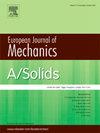Nonlinear dynamic analysis and optimization of sandwich plate and shell panels with auxetic core and functionally graded Zr-MgO/Al facesheets
IF 4.2
2区 工程技术
Q1 MECHANICS
引用次数: 0
Abstract
In the present investigation, the geometric parameters (rib thickness, inclined cell angle, vertical cell rib length, and inclined cell rib length) of auxetic honeycomb core and material parameters (volume fraction coefficient) of the functionally graded Zr-MgO/Al facesheets of the sandwich plate and shell panels are optimized for the first time. The dynamic analysis is carried out considering a higher-order shear deformation theory and employing a eight-noded isoparametric element with nine degrees of freedom per node. The material properties of the functionally graded material (FGM) facesheets are graded in the thickness direction according to a basic power law distribution in terms of the volume fractions of the constituents. The artificial bee colony algorithm is used to optimize volume fraction coefficient and different parameters of the auxetic core of the sandwich panel. The mechanical properties of the original material and the geometrical features of the unit cells are used to determine the mechanical properties of the auxetic core. The equivalent elastic parameters and density of facesheets are obtained using two micromechanical models i.e., rule of mixture (RM) and Mori–Tanaka (MT) methods. The analysis is further extended to nonlinear vibration analysis of FGM sandwich plate and shell panels. Geometrical nonlinearity is taken into consideration using the von Kármán type nonlinear strain–displacement equations.
Zr-MgO/Al功能梯度夹层板和壳壳板的非线性动力学分析与优化
本文首次对增塑型蜂窝芯的几何参数(肋厚、斜槽角、垂直肋长和斜槽肋长)和夹层板和壳板的功能梯度Zr-MgO/Al面板的材料参数(体积分数系数)进行了优化。考虑高阶剪切变形理论,采用C0八节点等参单元,每个节点9个自由度进行动力分析。功能梯度材料(FGM)表面的材料性能根据成分体积分数的基本幂律分布在厚度方向上进行梯度。采用人工蜂群算法对夹心板辅心的体积分数系数和各参数进行优化。利用原始材料的力学性能和单元胞的几何特征来确定增氧芯的力学性能。采用混合规则(RM)和Mori-Tanaka (MT)两种细观力学模型,得到了面板的等效弹性参数和密度。将分析进一步扩展到FGM夹层板和壳板的非线性振动分析。采用von Kármán型非线性应变-位移方程考虑几何非线性。
本文章由计算机程序翻译,如有差异,请以英文原文为准。
求助全文
约1分钟内获得全文
求助全文
来源期刊
CiteScore
7.00
自引率
7.30%
发文量
275
审稿时长
48 days
期刊介绍:
The European Journal of Mechanics endash; A/Solids continues to publish articles in English in all areas of Solid Mechanics from the physical and mathematical basis to materials engineering, technological applications and methods of modern computational mechanics, both pure and applied research.

 求助内容:
求助内容: 应助结果提醒方式:
应助结果提醒方式:


